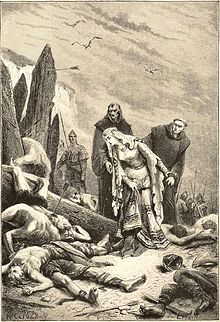

| Edith the Fair | |
|---|---|

Edith discovering King Harold's corpse after the Battle of Hastings (Horace Vernet)
| |
| Born | c. 1025 |
| Died | c. 1086 (age about 61) |
| Spouse | Harold Godwinson |
| Issue | Godwin Edmund Magnus Gunhild Gytha Ulf |
| Father | Thorkell the Tall |
| Mother | a daughter of Ethelred the Unready? |
Edith the Fair (Old English: Ealdgȳð Swann hnesce, "Edyth the Gentle Swan"; born c. 1025, died c. 1086), also known as Edith Swanneck,[note 1] was one of the wealthiest magnates in England on the eve of the Norman conquest, and may also have been the first wife of King Harold Godwinson.[1] "Swanneck" (or Swan-Neck) comes from the folk etymology which made her in Old English as swann hnecca, "swan neck", which was actually most likely a corrupted form of swann hnesce, "Gentle Swan" .[2] She is sometimes confused with Ealdgyth, daughter of Earl Ælfgar of Mercia, who was queen during Harold's reign.
Edith was born circa 1025, and is thought by some to have been a daughter of Thorkell the Tall and his wife, a daughter of Ethelred the Unready.[3][4]
Edith may have been the mother of Harold's daughters Gunhild of Wessex, who became the mistress of Alan Rufus, and Gytha of Wessex, who was taken by her grandmother to Denmark in 1068.[1] Gytha was addressed as "princess" and married the Grand Duke of Kiev, Vladimir II Monomakh.[5]
Though Harold is said to have lawfully married Ealdgyth, the daughter of Earl Ælfgar, the widow of the Welsh ruler Gruffydd ap Llywelyn whom he had defeated in battle, that marriage in spring 1066 is seen by most modern scholars as one of political convenience.[6] Mercia and Wales were allied against England, and the marriage gave the English claim in two very troublesome regions, and also gave Harold Godwinesson a marriage deemed "legitimate" by the clergy, unlike his longtime common law marriage with Edith the Fair.
Flint identifies Edith as the visionary known colloquially as "Rychold" or "Richeldis de Faverches", who authored Our Lady of Walsingham. The identification of Edith as the Walsingham visionary is rooted in his belief that the earlier date of the shrine's foundation, given by Richard Pynson as 1061, is credible. Pynson's history, which is given in a narrative poem known as the Pynson Ballad, had been previously thrown out by historians on the grounds it was unreliable as an oral narrative, but Flint defends the ballad on the grounds that Pynson was a respected historian, employed by King Henry VII, who also collaborated with John Leland. Flint contests the theories of J.C. Dickinson (1959) on the grounds that the 1131 Norfolk Roll, which Dickinson claims refers to the foundation of the shrine, actually refers to the foundation of the Priory of the Austin Friars, which preceded the foundation of the Walsingham Shrine (see p. xxii). He also notes that Edith Swanneshals was known within the court as "Rychold", meaning "fair and rich", and the appellatory title given by Pynson could therefore refer to the Anglo-Saxon Queen—a reference which is consistent with the original date given in the Pynson Ballad as 1061, for Edith Swaneshals was the Lady of the Walsingham Manor in this period (p. xxvii). Flint therefore establishes Edith Swaneshals as a Christian queen and the legitimate spouse of Harold Godwinson; as well as defending her Christian character as the probable visionary of the Shrine of Walsingham. In defending Edith's Christian character Flint cites her friendship with Wulfstan of Worcester.

According to folklore, Edith identified Harold's mutilated body after his loss to William the Conqueror at the Battle of Hastings.[7] Despite pleas by Harold's mother, Gytha Thorkelsdóttir, for William to surrender Harold's body for burial, the Norman army refused, even though Gytha offered Harold's weight in gold. It was then that Edith the Fair walked through the carnage of the battle so that she might identify Harold by markings on his chest known only to her. It was because of Edith the Fair's identification of the body that Harold was given a Christian burial by the monks at Waltham Abbey.[8] This legend is recounted in the well-known poem by Heinrich Heine, "The Battlefield of Hastings" (1855), which features Edith the Fair (as Edith Swan-Neck) as the main character and claims that the "marks known only to her" were love bites.
| International |
|
|---|---|
| National |
|